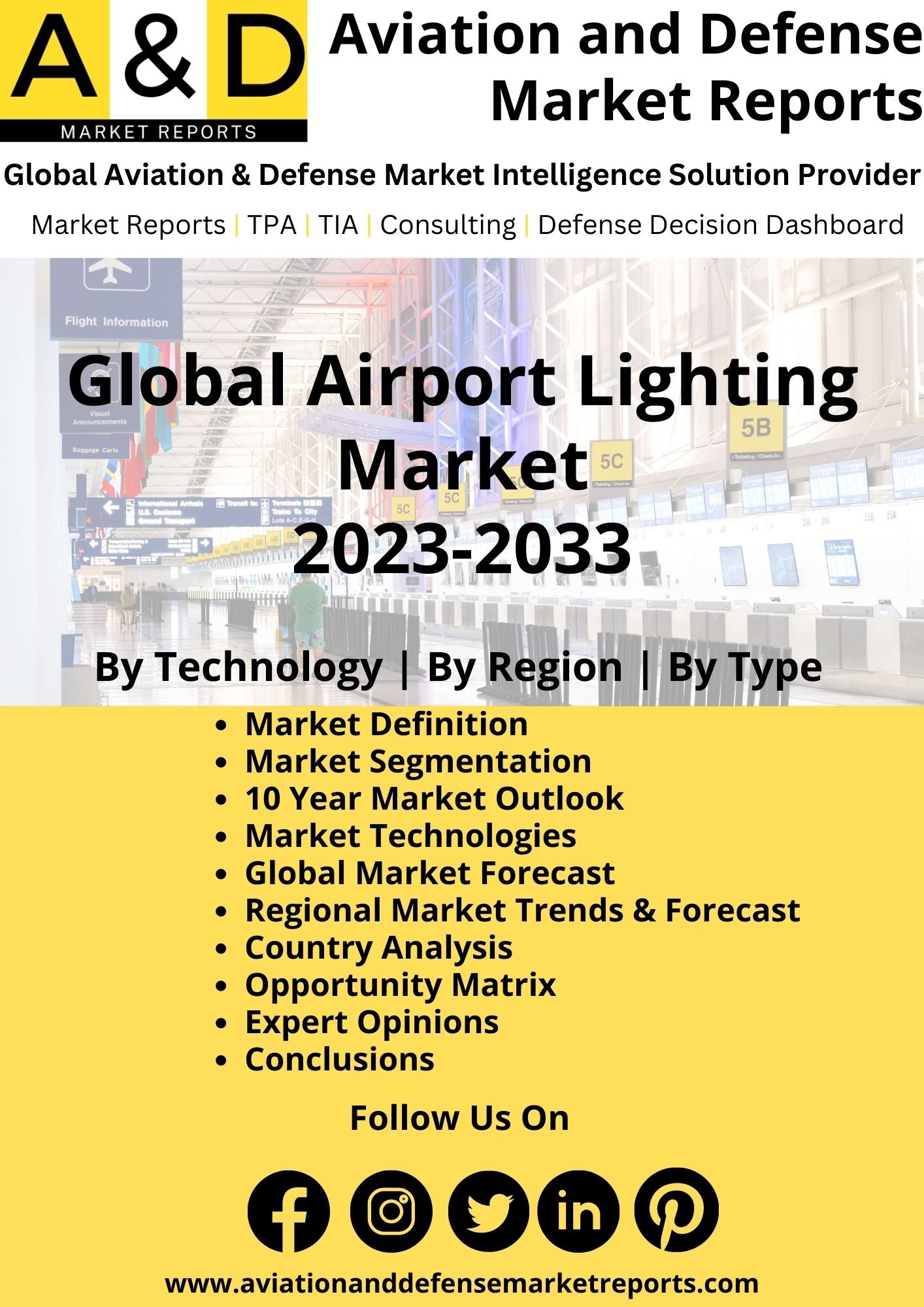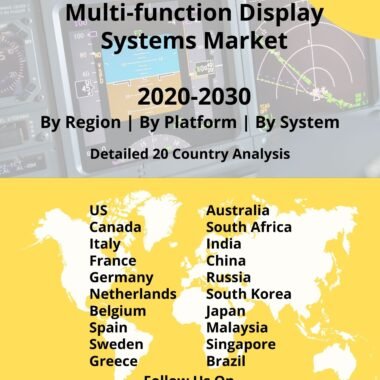Description
Airport Lighting Market
Frequently Asked Questions of Global Airport Lighting Market
Airport lighting market plays a crucial role in ensuring safe and efficient operations at airports, especially during low visibility conditions such as night-time, poor weather, or fog. It helps pilots navigate the airport environment, taxi safely on the runways and taxiways, and provides essential visual references for takeoff and landing. Runway lighting is essential for providing visual guidance to pilots during takeoff, landing, and taxiing. The primary runway lights include runway edge lights, threshold lights, touchdown zone lights, centerline lights, and runway end lights. These lights are typically white, but some airports may also use yellow lights to mark a displaced threshold or taxiway crossing. Taxiway lighting is installed along the taxiways to guide aircraft between runways, ramps, and terminals. It helps pilots maintain their position on the designated taxi routes and avoid potential hazards. Taxiway lights include taxiway edge lights, taxiway centerline lights, and taxiway lead-off lights. Taxiway edge lights are blue to distinguish them from runway lights.
Apron lighting refers to the lighting installed in the aircraft parking areas, ramps, and terminal aprons. These lights help guide aircraft during ground movements, especially in low-light conditions. Apron lighting facilitates safe aircraft parking, taxiing, and servicing operations. Obstacle lighting is used to mark tall structures, such as control towers, antenna towers, or buildings, to make them visible to pilots. These lights help prevent collisions with obstacles during takeoff, landing, or taxiing. Approach Lighting Systems assist pilots as they near their destination or target and land an aircraft. The Airport lighting market analysis typically includes various lighting components, such as approach light bars, sequenced flashing lights (flashers), and runway end identifier lights (REILs). These lights provide visual cues to pilots, aiding in the alignment and descent to the runway.
Visual Approach Slope Indicator (VASI) is a system of lights that provides visual descent guidance to pilots during the approach phase. It helps pilots maintain the proper glide slope for a safe landing. VASI systems typically consist of two sets of lights: red and white lights in a bar arrangement. The lights provide information on whether the aircraft is too high, too low, or on the correct glide slope. Another type of approach lighting system called Precision Approach Path Indicator (PAPI) helps pilots in accurately maintaining the appropriate glide path while approaching for landing. It consists of a row of lights that are either red or white, indicating the aircraft’s position relative to the optimal glide path. If the aircraft is too low, the lights appear red, and if it’s too high, the lights appear white.
Major factors driving Airport Lighting Market Growth
The Airport lighting market growth of the airport lighting market is influenced by airport expansion projects and the modernization of existing airports. As airports expand their infrastructure, additional lighting systems are required to support increased air traffic and accommodate larger aircraft. Moreover, existing airports often undergo lighting system upgrades to enhance safety, efficiency, and compliance with regulatory requirements. Regular maintenance and periodic upgrades of airport lighting systems are crucial to ensure their proper functioning and compliance with regulations. Airports invest in maintenance services and upgrade projects to improve lighting performance, reliability, and energy efficiency.
Trends Influencing the Airport Lighting Market Size
The airport lighting market size has seen advancements in technology that have led to more efficient and sustainable lighting systems. LED (Light-Emitting Diode) technology has gained prominence due to its energy efficiency, longer lifespan, and lower maintenance requirements compared to traditional lighting sources. LED lights are increasingly used in airport lighting systems, resulting in reduced energy consumption and operational costs.
Airport Lighting Market Forecast & Dynamics
The airport lighting market forecast is influenced by factors such as air traffic growth, airport infrastructure development, regulatory requirements, technological advancements, and the emphasis on aviation safety. The market is competitive, with several manufacturers and suppliers specializing The market projection encompasses an in-depth examination and assessment of the market, along with its magnitude. The examination entails an analysis of the regional market size, factors driving its growth, limitations, and potential opportunities. Additionally, the regional analysis provides insights into the Airport lighting market size specific to each country.
Airport Lighting Market Analysis for Recent Developments
SITIA, a new system for the efficient management of lighting on the aircraft parking apron at Alicante-Elche Miguel Hernández Airport, has been launched. SITIA is a technology advancement pioneered by airport operator Aena that will save 30% more energy than the previous model and has been certified by the State Aviation Safety Agency (AESA). The software developed has resulted in the ability to illuminate the aircraft apron, which has a total area of 439,000 m2, by zones and parking lots automatically and according to their use. To that purpose, tools previously utilized for controlling flight schedules and aircraft parking allocation have been incorporated, and the lighting tower projectors on the platform have been turned on and off.
The conventional lighting system at Mangaluru International Airport (MIA) has gradually been phased out in favor of an energy-efficient lighting system. According to an MIA release, the airport has completed a 100% conversion of lights to the new lighting system by replacing 1,111 traditional lights. The airport will save 188,558.96 kWH per year as a result of the move. The airport will save 1.17 lakh kWh per year by installing 752 LED lights in the National Air Traffic Services (NATS) building area, where the greatest savings would be realised. The MIA will save 56,467 kWH per year with 261 LED lights in the new integrated terminal building and 14,673 kWH per year by replacing the 98 conventional lights in the airside and the existing terminal building with LED lights.
The global landscape of airport lighting has seen significant advancements, contributing to enhanced safety, efficiency, and sustainability in aviation. Airport lighting report play a crucial role in facilitating safe aircraft movements on the ground, aiding pilots during takeoff, landing, and taxiing. Energy-efficient LED technology has become more prevalent in airport lighting, offering improved visibility, reduced energy consumption, and longer lifespan compared to traditional lighting sources. This shift contributes to both cost savings and environmental sustainability.
Innovations in smart lighting control systems, incorporating sensors and automation, optimize the use of airport lighting based on real-time conditions. This not only improves energy efficiency but also enhances operational flexibility. Precision approach path indicators (PAPIs) and runway lighting systems have evolved to provide more accurate guidance for pilots, especially during low-visibility conditions. These improvements contribute to safer and more reliable airfield operations. Global standardization efforts and compliance with aviation regulations ensure uniformity and safety across different airports worldwide. Collaborative initiatives also focus on incorporating cutting-edge technologies to address emerging challenges and continuously improve airport lighting systems in 2023.





